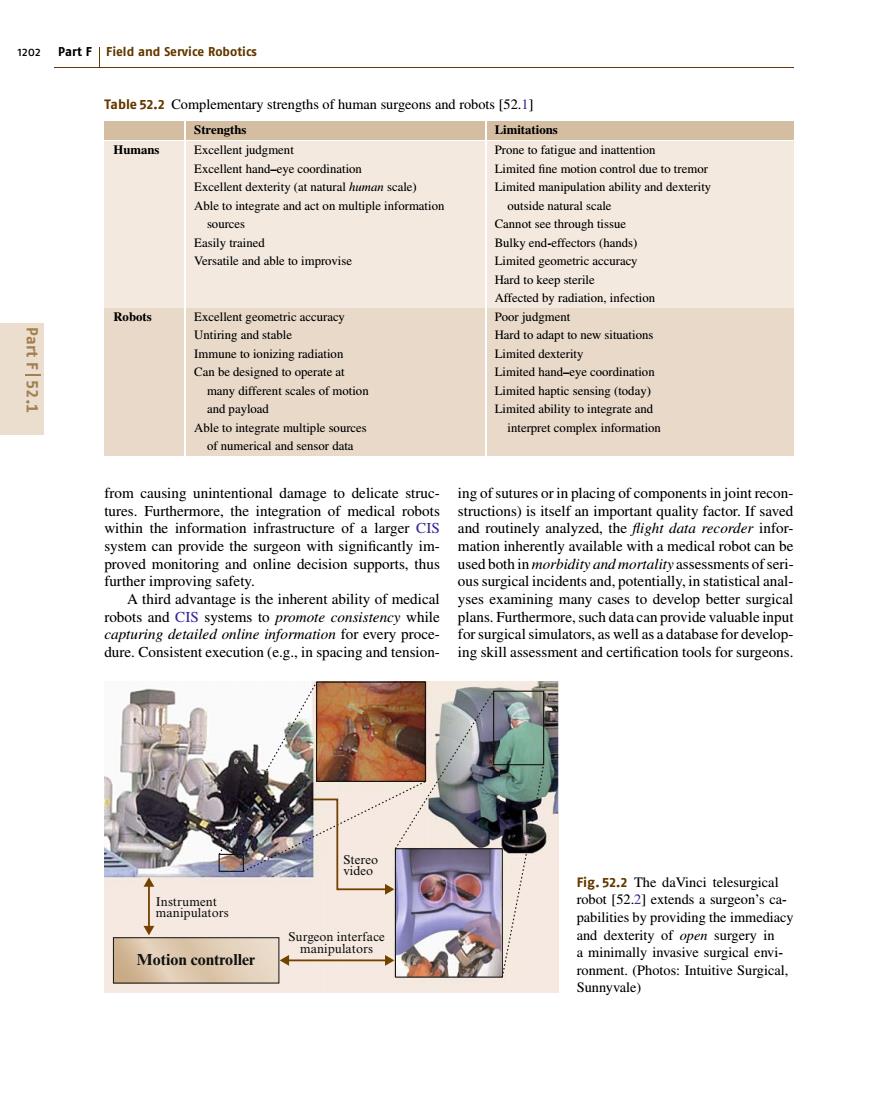正在加载图片...

1202 Part F Field and Service Robotics Table 52.2 Complementary strengths of human surgeons and robots [52.1] Strengths Limitations Humans Excellent judgment Prone to fatigue and inattention Excellent hand-eye coordination Limited fine motion control due to tremor Excellent dexterity (at natural hmnan scale) Limited manipulation ability and dexterity Able to integrate and act on multiple information outside natural scale sources Cannot see through tissue Easily trained Bulky end-effectors(hands) Versatile and able to improvise Limited geometric accuracy Hard to keep sterile Affected by radiation.infection Robots Excellent geometric accuracy Poor judgment Untiring and stable Hard to adapt to new situations Part F52.1 Immune to ionizing radiation Limited dexterity Can be designed to operate at Limited hand-eye coordination many different scales of motion Limited haptic sensing(today) and payload Limited ability to integrate and Able to integrate multiple sources interpret complex information of numerical and sensor data from causing unintentional damage to delicate struc- ing of sutures or in placing of components in joint recon- tures.Furthermore,the integration of medical robots structions)is itself an important quality factor.If saved within the information infrastructure of a larger CIS and routinely analyzed,the flight data recorder infor- system can provide the surgeon with significantly im- mation inherently available with a medical robot can be proved monitoring and online decision supports,thus used both in morbidiry and mortaliry assessments of seri- further improving safety. ous surgical incidents and,potentially,in statistical anal- A third advantage is the inherent ability of medical yses examining many cases to develop better surgical robots and CIS systems to promote consistency while plans.Furthermore,such data can provide valuable input capturing detailed online information for every proce- for surgical simulators,as well as a database for develop- dure.Consistent execution(e.g.,in spacing and tension-ing skill assessment and certification tools for surgeons. Stereo video Fig.52.2 The daVinci telesurgical Instrument robot [52.2]extends a surgeon's ca- manipulators pabilities by providing the immediacy Surgeon interface and dexterity of open surgery in manipulators Motion controller a minimally invasive surgical envi- ronment.(Photos:Intuitive Surgical. Sunnyvale)1202 Part F Field and Service Robotics Table 52.2 Complementary strengths of human surgeons and robots [52.1] Strengths Limitations Humans Excellent judgment Prone to fatigue and inattention Excellent hand–eye coordination Limited fine motion control due to tremor Excellent dexterity (at natural human scale) Limited manipulation ability and dexterity Able to integrate and act on multiple information outside natural scale sources Cannot see through tissue Easily trained Bulky end-effectors (hands) Versatile and able to improvise Limited geometric accuracy Hard to keep sterile Affected by radiation, infection Robots Excellent geometric accuracy Poor judgment Untiring and stable Hard to adapt to new situations Immune to ionizing radiation Limited dexterity Can be designed to operate at Limited hand–eye coordination many different scales of motion Limited haptic sensing (today) and payload Limited ability to integrate and Able to integrate multiple sources interpret complex information of numerical and sensor data from causing unintentional damage to delicate structures. Furthermore, the integration of medical robots within the information infrastructure of a larger CIS system can provide the surgeon with significantly improved monitoring and online decision supports, thus further improving safety. A third advantage is the inherent ability of medical robots and CIS systems to promote consistency while capturing detailed online information for every procedure. Consistent execution (e.g., in spacing and tensionStereo video Instrument manipulators Surgeon interface manipulators Motion controller Fig. 52.2 The daVinci telesurgical robot [52.2] extends a surgeon’s capabilities by providing the immediacy and dexterity of open surgery in a minimally invasive surgical environment. (Photos: Intuitive Surgical, Sunnyvale) ing of sutures or in placing of components in joint reconstructions) is itself an important quality factor. If saved and routinely analyzed, the flight data recorder information inherently available with a medical robot can be used both in morbidity and mortality assessments of serious surgical incidents and, potentially, in statistical analyses examining many cases to develop better surgical plans. Furthermore, such data can provide valuable input for surgical simulators, as well as a database for developing skill assessment and certification tools for surgeons. Part F 52.1